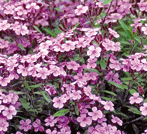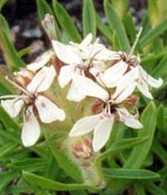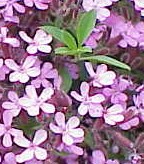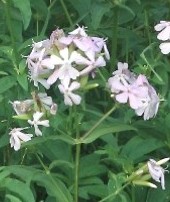 Saponaria is a genus of annuals and perennials in the pink family, Caryophyllaceae, native to Europe and Asia. Of the thirty to forty species in the genus, three perennials are considered suitable for the garden. The genus name Saponaria comes from the Latin sapo meaning soap plus the suffix –alis, meaning pertaining to sap. The leaves and roots of Saponaria officinalis, bouncing bet, contain saponin that produces a lather when boiled in water. The soap is a very gentle and is said to be useful for cleaning kid gloves.
Saponaria is a genus of annuals and perennials in the pink family, Caryophyllaceae, native to Europe and Asia. Of the thirty to forty species in the genus, three perennials are considered suitable for the garden. The genus name Saponaria comes from the Latin sapo meaning soap plus the suffix –alis, meaning pertaining to sap. The leaves and roots of Saponaria officinalis, bouncing bet, contain saponin that produces a lather when boiled in water. The soap is a very gentle and is said to be useful for cleaning kid gloves.
Saponarias have flowers with five petals and oppossite, entire leaves. Plants like lean, well-drained soil and are intolerant of heat and poor drainage.
Yellow Soapwort (Saponaria lutea)
 Native to the western Alps, this mat forming plant is a good choice for a rock garden. The pale green leaves are ½; wide and the flowers are yellow with purple stamens. This soapwort is more difficult to grow than the others.
Native to the western Alps, this mat forming plant is a good choice for a rock garden. The pale green leaves are ½; wide and the flowers are yellow with purple stamens. This soapwort is more difficult to grow than the others.
Size: 3-6” H x 6” W
Bloom Time: Begin early summer and continue for 3-4 weeks
Hardiness: Zones 5-8
Rock Soapwort (Saponaria ocymoides)
 This trailing semi evergreen soapwort is native to the eastern Alps and is the most popular of the soapworts. It is easy to grow and is especially attractive growing over rocks or a wall. The soft hairy leaves are ½-1” long, olive green, and paddle-shaped. The pink, ¼” flowers have purple stamens and are borne in loose terminal clusters. Several varieties are available that differ in flower size and color.
This trailing semi evergreen soapwort is native to the eastern Alps and is the most popular of the soapworts. It is easy to grow and is especially attractive growing over rocks or a wall. The soft hairy leaves are ½-1” long, olive green, and paddle-shaped. The pink, ¼” flowers have purple stamens and are borne in loose terminal clusters. Several varieties are available that differ in flower size and color.
Size: 6-9” H x 9” W
Bloom Time: Early summer
Hardiness: Zones 2-7
Bouncing Bet (Saponaria officinalis)
 Originally from southern Europe, bouncing bet has naturalized in parts of eastern and Midwestern US. The plant is upright and has 2-4” long dark green elliptical leaves. The pink flowers are 1- 1 ½ “ across and are carried in terminal or axillary clusters. Rich soil or too much shade result in floppy plants. Plants spread by stolons and can form a good sized colony in a few years. White and double flowered varieties are available.
Originally from southern Europe, bouncing bet has naturalized in parts of eastern and Midwestern US. The plant is upright and has 2-4” long dark green elliptical leaves. The pink flowers are 1- 1 ½ “ across and are carried in terminal or axillary clusters. Rich soil or too much shade result in floppy plants. Plants spread by stolons and can form a good sized colony in a few years. White and double flowered varieties are available.
Size: 12-30” h x 18” W
Bloom Time: Summer
Hardiness: Zones 2-8